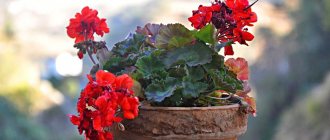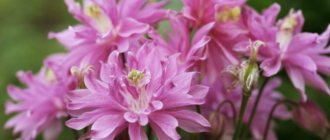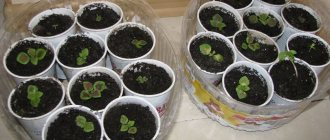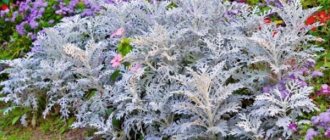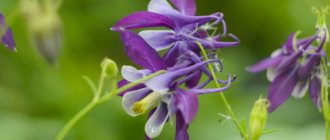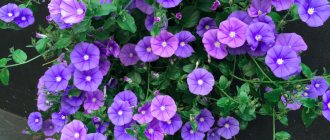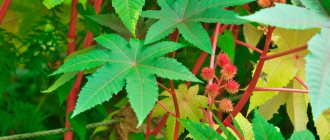Aquilegia is a pretty perennial also known as columbine. Most often in our gardens you can see hybrids and mixtures of varieties, but they are also quite good, and the species are simply irresistible. In this article we will tell you how to properly propagate a columbine with seeds: experienced gardeners can grow an entire clearing from one bag of seeds over several years.
Popular types and varieties of aquilegia
More than a hundred varieties of aquilegia have been bred, but only a few of them are grown decoratively. The following types are especially popular:
Alpine . With proper care of the plant, the stems of this type of aquilegia grow up to 30-80 cm in height. The flowers of this variety grow quite large, up to 5-8 cm in diameter. There are spurs on the flowers - they are slightly curved and not very long. The color palette of this species includes various shades of blue.
Alpine
Ordinary . It belongs to the European species, reaches a height of 40-80 cm. The flowers grow about 5 cm in diameter. Varieties of this species come in various shades, but blue and purple are the most common. Flowers come with and without spurs, simple and double. This species is resistant to severe frosts.
Fan-shaped . There is another name for this species - Aquilegia Akita. The stems of the plant grow up to 60 cm in height, and the flowers are large – more than 5 cm in diameter. The flowers have spurs - they are quite long and slightly curved. Up to 5 large flowers can grow on one peduncle. The main shades of the variety are blue, pinkish, lilac-violet. The flowers have a fuzzy white border around the edges. This type of aquilegia reproduces very well by self-sowing.
Hybrid . The flowers are quite large - they grow about 9 cm in diameter, they come in various shapes and shades, there are varieties with and without spurs, the flowers are both double and ordinary. The height of the plant stems can reach 1 m.
Canadian . The flowers of this species are red-yellow in color, with long spurs. This type of aquilegia grows well in the shade and loves moist soil.
Dark . The flowers are small - up to 4 cm in diameter, drooping, dark shades predominate. The spurs are small, but very beautifully curved. Flowering of this species begins in early summer. Grows well in both partial shade and shade. With insufficient watering, it can quickly wither in sunny areas.
Skinner's Aquilegia .
The flowers are drooping, red-yellow in color, the spurs are long and straight. This type of aquilegia is not afraid of frost. Tolerates even the coldest winters well. Aquilegia goldenflower . The flowers are large, with a golden tint and long spurs. Tolerates cold and dry weather well.
Aquilegia olympic . Height is 30-60 cm, the stems are covered with thick fluff. The flowers are light blue, quite large – about 10 cm in diameter. There are long spurs. Flowering period is May-June.
In addition to these species, there are other varieties of aquilegia, for example, ferruginous, blue, small-flowered and bicolor, Siberian and others.
The most popular varieties of Aquilegia:
- Barlow Rose. Plant height is up to 80 cm. The flowers are large, pale pink in color, with a terry border.
- Winky. This variety is often used for garden and indoor floriculture. The height of the plants is no more than 35 cm. The flowers are red, purple, pink, directed straight upward. Blooms in May-June.
- Blue Star. Large flowers, up to 10 cm in diameter. The color is dark blue with a white core. Height is about 80 cm.
Conditions for seed germination
If preliminary measures were carried out in compliance with the rules, the seedlings will receive maximum charge for active growth and endurance after transfer to open ground.
But it is necessary to comply with the necessary conditions (temperature, watering, lighting).
Temperature, lighting and humidity
The temperature regime depends entirely on the chosen stratification method. If the seeds were sprouted, then after planting in the soil they are covered with film and sent to a well-lit place. Mode: 18-20 degrees.
If planting was carried out according to the third scheme (in moist soil), then the container with the covering material is placed in the refrigerator. Further actions are carried out after 28-32 days.
Since lighting is not enough in spring, it is better to add lighting. Daylight hours for seedlings should not be less than 14 hours. At the same time, direct sunlight negatively affects the development of aquilegia. Diffuse lighting is required.
Watering and fertilizing
Until the sprouts appear, watering is carried out using a spray bottle. You can also use the drip method. A syringe is used for this. Water is introduced slowly.
Humidity level: moderate. Overwatering poses a risk of fungus development. Drying out is the drying out of the root system.
Fertilizer mixtures are not required throughout the development of seedlings. Aquilegia has enough substances from the soil mixture.
When to sow aquilegia for seedlings
Aquilegia can be grown for seedlings in containers or in open ground, and sowing can be done both in spring and autumn.
Spring sowing in seedling boxes is usually carried out in March, but preparatory work (stratification, scarification) begins a month before - in late January-early February. And when 3–4 true leaves appear on the plants, they are transplanted into open ground.
When sowing in autumn in open ground, stratification is not required. Aquilegia seeds can be sown in a temporary bed. When the seedlings appear in the spring and grow a little, they are transplanted directly into the flowerbed.
Specifics of growing flowers for seedlings
Since all varieties of aquilegia bloom early, seeds are sown for seedlings in March-April. Vegetative propagation is best done in the spring. Before planting and planning a pattern or combination of cultivated plant species, carefully study the varietal characteristics and care rules.
If you want to admire aquilegia at home, you should choose small varieties: Vinke is perfect for decorating an apartment.
Selection and preparation of soil and container
Aquilegia manifests itself in its low maintenance requirements in almost everything. So, both self-prepared and purchased soil mixtures are suitable for seed material. For a young plant, it is still better to take a universal soil, which is light and loose.
If you create the soil mixture yourself, you will need:
- sand (exclusively river, fine);
- humus or peat;
- leaf and turf soil.
After mixing the ingredients, disinfection is required. You can use manganese solution or boiling water. After the procedure, the land for planting is left to settle for 10-12 days.
The container for aquilegia must be elongated. Reason: the root grows quickly, the type is taproot. A box or bowl is suitable, but it must be tall. Drainage holes are required.
Seed preparation
The first thing a gardener should pay attention to when purchasing seeds is the expiration date. Must be no more than a year from the date of collection. With a shelf life of 2-3 years, there is no guarantee for excellent germination.
Growing aquilegia from seeds step by step
Before sowing seeds for seedlings, preparatory work is first carried out, and then the sowing itself is carried out.
Preparing the soil and container
Aquilegia loves light soil that does not accumulate moisture and is moderately nutritious.
To grow aquilegia from seeds, you can use a universal mixture that is sold in specialized stores, or you can prepare it yourself.
You can use the following mixture options:
- turf soil, leaf soil, humus, river sand;
- turf soil, humus, sand.
All components are taken in equal parts.
It is better to grow seedlings in tall boxes or containers so that the long roots of the plant can go deeper. But at first, seeds for seedlings can be planted in small containers (for example, plastic containers with lids). And in the future it will be possible to transplant the seedlings into separate and deeper containers (pots or cups), in which drainage holes will need to be made.
About a day before planting the seeds, the substrate is poured into the container and lightly compacted. The soil is watered and excess liquid is allowed to drain out.
Before sowing the seeds, the soil must be sifted well to make it looser. This will help the seeds to hatch quickly and easily. It is also necessary to disinfect the soil by spilling it with a fungicide or adding phytosporin to the substrate.
Seed preparation
Aquilegia seeds are active only for one year, then their vital energy weakens significantly. To provide yourself with good seed material, you can use the following tips:
- seeds are sown immediately after they are collected;
- the collected seeds are stored in a cool, dark place;
- a month before planting, stratification or scarification is carried out;
- treat the seeds with a solution of growth stimulants.
As mentioned above, when sowing in spring, the seeds must be hardened. With the help of hardening, you can achieve more active and friendly shoots. The seed material is kept in the refrigerator (i.e. subjected to stratification) for 1-1.5 months, at a temperature of 0 +5°C. Seeds are placed in damp sand or on moistened cotton pads.
You can also carry out scarification (exposing the seeds to heat) - the seed is kept for about 30 days at a temperature of +34-36 °C.
Important! Stratification or scarification improves seed germination. But this does not mean that without these agricultural techniques nothing will germinate, especially if you do not doubt the quality of your seeds.
Sowing
Sowing aquilegia seeds for seedlings step by step:
- The container or box is filled with a nutrient mixture.
- The soil is well moistened with a spray bottle.
- The seeds are evenly distributed over the entire surface of the soil and sprinkled with 0.5 cm of soil.
- The plantings are moistened with a spray bottle.
- The container is covered with a lid (if a container is used) or covered with film to create a greenhouse effect.
- Containers with plantings are placed in a warm place. Aquilegia seeds germinate well at air temperatures of + 18-22 °C.
When the first shoots hatch (about 10-14 days), the cover is removed.
Advice! Since aquilegia seeds are very small, it is convenient to plant them using a toothpick, which must first be moistened with water.
Sowing aquilegia in the snow - video
Sow aquilegia seeds in exhaust gas
If we sow fresh, personally collected seeds in which we are confident, then it is better to plant in the fall. In this case, we don’t need any dances with buns, we simply sow them like any other perennial seeds:
- We choose a suitable place, always in partial shade. In the sun, columbine plants will not bloom for long, and their famous bright lacy foliage will have a rather pale appearance.
- We prepare the soil, dig it well and loosen it, add organic fertilizers (humus, compost, etc.).
- Carefully distribute the seeds on it, sprinkle it with a layer of earth, the thickness of which in no case should exceed 0.5 cm.
- Mulch with a thin layer of any mulch: compost, leaves, etc.
- We are waiting for shoots in the spring.
Soniy Member of FORUMHOUSE
I sow the seeds on the surface of the ground; planting too deep is one of the reasons for poor seed germination. It takes a long time to germinate, 20-30 days.
This is the simplest, most reliable and preferred method. But some gardeners like to sow aquilegia in April or early May, depending on the climate of your region.
In the spring, we sow the seeds of the catchment in the OG only in warm soil!
But in April, the seeds are no longer as fresh as in October, so stratification in the same way as when grown by seedlings.
We also sprinkle the seeds that have undergone stratification with 0.5 cm of soil, but in this case we must cover the top with film and water them regularly.
We do not remove the film until friendly shoots appear - this may take a month or more.
Seedling care
Growing aquilegia seedlings need sufficiently long daylight hours and moderate watering. Water moderately so as not to provoke the appearance of a “black leg”.
Aquilegia develops a root system quite quickly, and it also has a very long taproot, so if the seeds were sown in a shallow container, then when the seedlings have 2-3 true leaves (about 30 days after planting), it will need to be transplanted into deeper containers (with drainage holes).
Do the dive in the morning or evening. Immediately after transplanting, the plants are well watered. In the future, watering should also be moderate as the top layer of soil dries. Every 10-14 days, seedlings are fed with complex fertilizers.
Preparing for sowing
The catchment does not tolerate vegetative propagation by dividing the bush. The best way to get a specimen of aquilegia for your garden plot is to grow seedlings from seeds.
Seed material
Only seeds that are no more than one or maximum two years old are suitable for germination. The packaging with watershed grains must contain all the necessary information: description of the variety, optimal temperature for germination and expiration date. If there is no data, it is better to choose seeds from another manufacturer.
You can also collect seed from your own garden plot. The most suitable time is the end of August, when the seed pods form after flowering. They need to be wrapped in gauze, then cut and dried on the windowsill. Aquilegia grains are stored in a cool, dry place away from children, as they are toxic.
The material for sowing requires preliminary stratification - creating a moist and cool environment of +1-4°C. This procedure involves an accelerated imitation of natural processes: wintering in the ground, spring thaw and germination. Stratification at home takes 30-35 days.
You can prepare catchment seeds for sowing in one of three ways:
- The seeds are placed between moistened cotton pads, placed on a lid or saucer, wrapped in a bag and placed in the refrigerator.
- The columbine grains are mixed with a small portion of river sand calcined in the oven, moistened generously, wrapped in cellophane and placed in the refrigerator.
- The seed material is sown in the ground, then the container is carefully wrapped in film and placed in the refrigerator. After 30-35 days, the container with the seeds is taken out and placed on the windowsill.
If with method 3 the sprouts appear before the specified period has expired (30-35 days), the container must be removed from the refrigerator and placed in a warm and bright place.
Soil for sowing seeds
To grow aquilegia seedlings, it is best to prepare the soil yourself. Deciduous soil, turf, river sand and compost should be combined in equal proportions. If you can’t make such soil, a standard composition intended for flower seedlings will do.
The soil should be disinfected to remove pathogenic bacteria, weed seeds, and pest larvae. Any of the following methods are suitable for disinfection:
- freezing - the earth is alternately placed in a sub-zero environment (-15-20°C) or in a positive environment (+18-20°C) for a period of 7 days. The temperature regime changes three times - cold, warm, cold;
- steaming - the soil is kept above water vapor for 1.5-2 hours, mixed every half hour;
- calcination - this type of soil treatment involves half an hour of treatment in an oven preheated to 90°C.
After all the necessary procedures have been carried out, the soil should be sifted and sprinkled with Fitosporin.
Container for seedlings
To plant aquilegia seeds for seedlings, you need a deep box with sides at least 20 cm high, since the plant has a long taproot. If there are no drainage holes in it, you must make them yourself: the plant does not tolerate stagnant water. If liquid accumulates in the soil, the root system will rot and the seedlings will die.
You can also sow catchment seeds in individual plastic cups. In this case, the requirements for containers are the same: the pots must be deep (20-25 cm) and drained.
Peat tablets are also suitable for growing aquilegia seedlings. Before use, they are filled with water and wait for the nutrient substrate to swell. Then the excess is drained, a grain is placed in the recess of the swollen cylinder, after which all that remains is to wait for the shoots. Watering is done as needed.
When to plant aquilegia in open ground
When the threat of return frosts has passed, the plants are transplanted into open ground. This happens about a month after picking (or two months after planting the seeds); by that time the seedlings will have grown well and become strong. It is better not to rush with the transplant and wait until the air warms up to at least +15°C.
Important! The plant can withstand temperature drops of no more than +5 degrees.
Aquilegia is a fairly unpretentious plant; it can be planted both in the sun and in partial shade, and even in the deep shade of garden trees or bushes, since it is shade-tolerant.
Planting aquilegia seedlings in a permanent place occurs as follows:
- Choose the most suitable place on the site in partial shade or shade;
- Prepare holes according to the size of the container in which the seedlings grew;
- Water the planting container in advance so that you can easily remove the seedlings from it.
- Carefully remove the plants, place them in the holes, sprinkle them with soil and press them down.
- Seedlings are planted at a distance of at least 30-35 cm from each other.
- Planted plants are well watered.
- The space between the plants and the ground around the stems are well mulched. You can use hardwood sawdust, hay, straw or dry peat as mulch. Mulch will help retain moisture and prevent increased weed germination.
In the first year, for aquilegia, choose a place protected from the wind and protected from direct sunlight, since young plants can simply burn under the scorching sun.
The land for planting is prepared in two to three weeks:
- dig up;
- make deep holes (about 25 cm) so that the seedlings fit together with the earthen ball;
- if necessary, lay out a drainage layer;
- a small amount of humus or compost is placed at the bottom of the holes;
The seedlings are placed in prepared holes, covered with soil and well moistened.
We grow aquilegia using seedlings
Seeds for seedlings are sown at the end of January or February. For growing in seedlings, the following soil composition is recommended: 1/3 humus, 1/3 turf soil, 1/3 sand. At FORUMHOUSE we told you how to make leaf and turf soil yourself.
We fill a deep container for seedlings with soil, water it well with warm water, sprinkle with stratified seeds and sprinkle literally a couple of millimeters of soil. It is advisable that the soil be sifted, this will ensure even seedlings.
To obtain strong seedlings, it is recommended to keep containers with crops at a temperature of +16 - +18 degrees. This is the ideal temperature. Water the young entrances very carefully, avoiding both flooding and overdrying. Direct sunlight is also unacceptable.
After the appearance of the second true leaf, the seedlings dive: ideally immediately into the exhaust gas, but also into peat pots. As a last resort - in large boxes. The most important thing is careful handling of the rhizome; it should not be damaged. Adult seedlings are cared for in the same way as seedlings; you can provide additional lighting.
In OG, aquilegia seedlings are planted at a distance of 20-40 cm between plants, depending on their size. Young aquilegias are delicate creatures, so at first it is important to protect them from aggressive weeds by regularly weeding them. You should also be sure to carefully loosen the soil after each rain or watering. It is better not to be overzealous with watering; adult plants are generally recommended to be watered only during drought.
Sometimes aquilegias bloom in the year of planting. In this case, it is important to prevent seed setting - cut the flowers and let them please you in the bouquet.
Catchments are easy to care for - in addition to rare watering and weeding, pre-winter mulching with humus or peat is carried out, and in the spring the perennial is slightly pestered so that its rhizome is not exposed and does not rise.
How to properly care for aquilegia in summer
In the first year after planting, aquilegia does not bloom; all the plant’s efforts are aimed at adapting to a new place and growing a powerful root system.
But already in the second year after planting - at the end of May-beginning of June, you can enjoy the first flowers. Aquilegia blooms in full force only in the third year after planting.
Caring for a planted plant comes down to the following procedures:
- Timely removal of weeds and loosening of the soil.
- Fertilizer application.
- Moderate soil moisture. The plant has a rather long central root, so it rarely suffers from lack of moisture.
- Tying up tall species. The plants are tied to wooden stakes using twine.
As the roots of aquilegia grow, they often begin to protrude from the ground; they are sprinkled with rotted peat or just a new ball of soil. This procedure is carried out in spring and summer.
For lush flowering (2-3 weeks after planting), mineral fertilizers are applied:
- superphosphate – 50-60 grams per 1 sq. m;
- potassium salt – 15-20 grams per 1 sq. m;
- saltpeter - 20-30 grams per 1 sq. m.
In summer, aquilegia is watered with organic fertilizers. Use diluted manure and urea. You can also use ready-made complex fertilizers. This will help the plant gain more green mass.
Grown plants that are already 2-3 years old are fed twice a season. In spring, nitrogen fertilizers are used, and when buds appear, potassium fertilizers are used.
Aquilegia is one of those plants in which it is necessary to remove dry (which have already bloomed) flower stalks so that the plant does not waste its energy on setting seeds.
Wintering of Aquilegia
There is one more type of work that needs to be done after the aquilegia blooms. The fact is that in four- to five-year-old plants, the roots begin to protrude from the ground, which affects young leaves and shoots, so after removing the peduncle, you need to pour peat manure compost with humus under the bush to cover these roots. In this way, the aquilegia will receive additional feeding before winter and at the same time will be protected from frost by mulch.
Plant lupine in the garden - a beautiful flower and green manure
Methods for propagating aquilegia
Aquilegia can be propagated not only by seeds, but also by cuttings and dividing the bush.
Cuttings are considered the simplest method of plant propagation. Cuttings are harvested in the spring, long before the leaves begin to bloom. First, young and large shoots with internodes are cut off.
The cut is treated with a growth stimulator. Shoots are planted directly in open ground, but you can start by planting them in any container. Next, the cutting is covered with plastic wrap or a plastic bottle.
For the first 10 days, the shelter in the plants is not removed at all, and then it is periodically ventilated (no more than half an hour a day) and moistened the soil. The cuttings are planted in loose soil with good drainage. When planting, add coarse granulated sand. When the cuttings adapt and take new roots, they are transplanted to a permanent place of growth.
The method of dividing a bush is not used very often. It is used, as a rule, if there is a need to preserve a plant variety. The roots of aquilegia grow quite deep into the ground, the plant is fragile and does not tolerate the procedure of division and replanting. The bush is divided in early spring, or in early September. For division, use bushes that are more than 3 years old.
The procedure for dividing aquilegia is carried out as follows:
- The bushes of the plant are dug up, the roots are well cleaned of adhering soil.
- All stems are trimmed and leaves are completely removed.
- The root is divided into two even parts. Both divisions must have healthy buds and strong roots.
- The place where the cut was made is well treated with crushed coal, and the cuttings are carefully planted in previously prepared soil.
- The soil is pressed well and watered.
Description of the plant
Let's talk a little about the name of the perennial plant. The flower acquired its name from two Latin words - “water” and “to collect”. That is, literally it turns out - a catchment , this is the second name of aquilegia. The plant is also called “ Orlik ”, and in the USA and England - “Columbine”.
In addition to the method of growing from seeds, the plant can be propagated by dividing the bush.
When growing aquilegia from seedlings, flowering occurs in the second year after planting in open ground. The plant blooms in May or June.
Perennial flowers can have different pleasant colors: white, pink, blue, lilac, etc. There are tall, low-growing varieties and even varieties with double flowers.
The height of the plant can vary from approximately 40 to 100 centimeters. The size of the flowers is approximately 3-8 centimeters in diameter.
The columbine is a shade-loving, moisture-loving, cold-resistant and unpretentious plant.
How and when to collect your seeds
Aquilegia seeds are sold everywhere, and you can buy them at any flower shop, or you can collect them yourself from plants already growing on the site. If this plant is already growing in your garden or flower bed, then the seeds for its propagation can be collected very simply. They are also stored well, and do not lose their quality throughout the whole year.
Aquilegia seeds begin to ripen in early August and are harvested immediately after small green pods appear on the stems. If they are not collected in time, they begin to crumble to the ground. It is necessary to dry the seeds at room temperature, placing them on a saucer or on a napkin.
But you can also not collect the seeds, but leave them on the bushes, then you can reproduce by self-sowing.
Diseases and pests
Watersheds are quite susceptible to diseases and pest attacks:
- Powdery mildew is a white coating on stems and leaves. Spraying with Fitosporin-M, Hom, and Fundazol helps. Treatment needs to be done every 7-10 days.
- Gray rot - gray-brown spots of mold appear on the plant. It spreads very quickly and moves from one plant to another. To combat this disease, you can use Bordeaux mixture or a solution of fungicides. But the most effective way is to remove and burn the affected parts; the faster, the better.
- Rust fungus - bright red spots appear on the lower surface of the leaves, then the affected areas of the plant dry out and die. The spores are quickly carried by the wind and can cause enormous damage to the entire garden. The drug “Topaz” is suitable for treating rust fungus.
- Invasion of aphids - parasites cover the roots, leaves and flowers of aquifers, sucking the sap from the plant. To combat, a soap solution or insecticide is used.
- Spider mite - entangles aquilegia with a web, inside which a colony of microscopic insects develops. When the first signs (yellow dots) appear, you need to spray with “Kleschevit” or “Fitoverm” not only the bushes themselves, but also the plants nearby.
- Nematodes are worms that slow down the development of a plant and disrupt its integrity. It is recommended to destroy the affected plants and treat the soil with pesticides: Nefamos, Dimethoate, or Vidat.
Despite some disadvantages, such as poor germination and high toxicity, aquilegia is completely worth the care effort. From year to year this beauty will bloom more and more magnificently and attractively. Flower growers undertake to grow seedlings from columbine seeds because white, pink, blue and lilac flowers will also please the eye in shady corners of the garden - where other plants will die.
Pruning the plant after flowering, preparing for winter
When the plant has finished blooming, remove all flower stems, as they have already lost their decorative beauty. They also inspect the entire bush at the same time - remove dry and damaged leaves. You can also cut off the entire above-ground part of the bush, because with the arrival of spring new stems will grow.
It is also very important to check the base of the flowers; in mature plants (over 3 years old), roots begin to emerge from the soil. To prevent the plant from freezing in winter, all roots protruding from the ground are covered with compost, pre-mixed in equal proportions with manure. Such a shelter will protect the roots well from severe frosts and serve as additional fertilizer.
With such a variety of aquilegia varieties, every gardener will be able to choose a variety that will decorate his plot with delightful flowers. You can choose several types of this plant and create a fabulous composition that will decorate your garden or local area.
Aquilegia after flowering
When the aquilegia fades, the stems that have lost their decorative effect are cut back to the rosette of leaves. Parts of healthy plants can be used for compost, but diseased plants should be burned to prevent contamination of the soil and other plants. If you want to try the seed propagation method, leave peduncles with flowers of the varieties you need for the seeds to ripen, putting gauze bags on the fruit to avoid self-seeding. After flowering, you can start dividing the bush and at the same time planting plants. At the same time, in September-October, seeds are sown before winter.
In the photo: Grown from aquilegia seeds
Aquilegia in landscape design - photo
Aquilegia yellow
What do aquilegia seeds and seedlings look like?
Aquilegia, or catchment (Aquilegia) is a perennial ornamental plant with a two-year development cycle. In the first autumn, after flowering, it forms a basal rosette of leaves. After wintering, the plates die off, making room for new ones. At the end of spring or at the beginning of summer, another flowering shoot rises from the center of a fresh rosette.
Aquilegia seedlings have trifoliate sessile or petiolate leaves. As it develops, it grows to 40-100 cm. From late May to mid-summer it bears large orange, yellow, white, blue or pink five-petalled buds with thin spurs up to 7 cm long.
After flowering, the catchment forms multileaf fruits. The photo of aquilegia seeds shows that the grains of the crop are black and shiny, very small.
Aquilegia seeds are poisonous, so you need to be careful when sowing
Care
Aquilegia is easy to care for. She is unpretentious and does not make any special demands
You need to water regularly. It is produced as the soil dries. The long root obtains moisture at depth, but it is impossible to leave the bushes completely without watering.
The bushes are watered using a watering can, simulating rain. Flowers accumulate drops of water; it is not without reason that it is called a catchment area. In the sun they shimmer beautifully.
The soil should be light. It is necessary to weed around and loosen the soil. To prevent self-seeding of aquilegia, after the flowers wither, they are removed. This must be done before the fruit is ripe and the seeds are released into the wild.
To collect the seeds, the formed fruits can be tied with gauze. When opening them, such a bandage will partially protect them from spilling onto the ground.
The maximum growth period of the bush is 4 - 5 years. If you leave it longer, the flowers will become smaller. The petals may lose their bright color.
As the plant ages, its roots begin to protrude from the ground . In the fall, after pruning the plant, they can be seen. They need to be sprinkled with soil containing humus, peat or compost. This will cover the root system, provide additional nutrition and keep you warm during the winter frosts.
Fertilizers
During the season you need to fertilize the plant 2 - 3 times.
You can fertilize with diluted manure at the rate of 1 bucket per 10 bushes or with mineral fertilizers.
- The first feeding is carried out in early May . You can use organic fertilizers for it. For example, "Flower". 1 tablespoon is diluted in a bucket of water. You need to water at the root, without touching the leaves.
- During flowering, approximately the beginning of June . You can use urea and nitrophoska solution.
- After the flowers wither , feed them with urea or potassium sulfate.
How to propagate Aquilegia
We have already described above how to propagate aquilegia by seed. But here’s the problem: if you like a particular variety, the seed propagation method is not an option for you. The fact is that in the front garden or flowerbed, aquilegias cross-pollinate and actually cross with each other. Therefore, a columbine grown from seeds collected independently in a flower bed is unlikely to resemble the plant that gave you the seed. If you want to grow a “baby” that will be identical to the mother flower, use other methods of propagating aquilegia. For example, cuttings or dividing a bush.
Aquilegia cuttings
In this case, the cuttings are young basal rosettes on which leaves have not yet appeared. Cuttings need to be separated and planted in spring or autumn. Read more about how to do this below.
- Manually break off the root rosette as close to the ground line as possible.
- We use a special powder that stimulates the formation of roots to treat the cut site.
- Mix river sand and peat in equal proportions, fill the container with this substrate and moisten it thoroughly.
- We deepen the planting material literally one centimeter and manually compact the substrate thoroughly around the outlet.
- We shade the rosettes from direct sunlight and regularly water them until they take root. Once this happens, watering can be minimized.
- It is advisable to organize a greenhouse over the “baby” from a plastic bottle or jar. The cap must be removed periodically, giving the “baby” the opportunity to breathe fresh air.
The rosettes used to propagate aquilegia in the spring take root well by the end of summer. If the rosette was planted in the fall, it will become a full-fledged plant by next spring. It is very advisable to organize a shelter for fragile aquilegia so that the plant feels as comfortable as possible in winter.
Dividing an aquilegia bush
Dividing a bush is far from the most effective method of propagation, since damage to the root system can lead to the death of the aquilegia: both the one that is separated and the one from which it is separated. However, there are situations when division is the only option. For example, when the plant is more than five years old and the bush itself actually breaks up into separate parts that require replanting. Well, or when a gardener wants to propagate a specific variety at any cost, preserving all its characteristics.
- Carefully dig up the rhizome, take a sharp knife and cut the root so that at least two buds remain on each of the resulting sections.
- We plant each division in a separate hole, water it thoroughly and then stop watering. Next time the soil will need to be moistened only if there is no precipitation for a long period.
It is not recommended to feed aquilegia divisions planted in the ground. You can start applying fertilizers to the bush only after the plants have fully adapted to the new realities and taken root.
Aquilegia “lives” up to five years. After this, the bush loses its decorative effect and disintegrates. Therefore, after five years, the bush must either be divided or eliminated, replacing the old plant with a younger one.
Recommendations and common mistakes
When growing aquilegia from seeds, you need to follow some rules before and after sowing and avoid common mistakes:
- The columbine prefers sunny and warm areas in the garden. But young seedlings of the crop remain rather weak in the first year of life and can overheat in a lighted flower bed. Therefore, they are first planted in a temporary area, and next season they are transferred to a permanent place.
- When sowing seeds for seedlings, stratification should not be neglected. Without hardening, the risk of loss of planting material increases. The catchment may not sprout at all or produce weak, few sprouts.
- After sowing, when growing seedlings, it is necessary to protect the crop from cold drafts and sudden temperature changes. Conditions must be stable and mild.
Although aquilegia loves moisture, it does not need frequent watering after sowing and transferring to the ground. The long root allows the plant to extract water from deep layers of soil. It is necessary to moisten the perennial moderately as the top layer of soil dries.
Attention! The seeds remain viable throughout the year. For sowing seedlings, only fresh grains are used; old planting material most likely will not germinate.
Aquilegia, after sowing with seeds, begins to bloom only in the second year of life.
Description and features
From 60 to 120 species have been described, 35 of them are cultivated, that is, hybrid varieties, since wild ones, as a rule, do not take root in garden conditions.
The name translated from Latin can be interpreted in two ways:
- Collecting water - catchment area (Russian).
- Relates to the word "eagle". In some areas the name “eagles” is found.
The plant is one of the few that has the “lotus effect” - the ability not to be wetted by water. Moisture, falling on the surface of the sheet, curls into drops and collects along the edges or in the center.
Lotus, reed, nasturtium and others are endowed with this property. The wings of many lepidoptera - butterflies - are constructed according to a similar principle.
Greens and shoots go through two phases of vegetation in one annual cycle. At the first stage, at the base of the peduncle after flowering, a bush of leaves is formed in the immediate vicinity of the roots.
In winter they remain green and die off only in spring, instead of them new dissected trifoliate leaves are formed on towering petioles and then tall peduncles.
The flowers of the columbine are drooping, arranged singly and consist of five funnel-shaped petals bordered by spurs, their length varies depending on the species. It is their presence or absence that serves as the main difference between the types of aquilegia - in size, length, and upward bending.
The colors of the buds can be different: blue, yellow, red. In nature, two-color and terry varieties are described. The flowering of hybrid forms is very diverse.
Is a honey plant. The seeds are small, shiny, dark, poisonous.
A columbine is a plant that is used in garden design only in a hybrid form. Wild species are not grown in gardens. Aquilegia bushes retain their decorative properties for up to 5 years. After which they need to be replaced with new ones.
Aquilegia flowers look like orchids from a certain angle. Due to the intricately curved shape of the petals, they are compared to elf slippers.
Recently, the watershed has gained great popularity. It decorates the landscapes of parks and gardens, especially where there are decorative ponds.
Natural habitat
In nature, Aquilegia lives in the Northern Hemisphere: central and southern Europe, Scandinavia and some parts of Asia, as well as in North America. American species differ from Eurasian ones - the former have very bright flower colors: golden, orange or red. But European plants chose more delicate tones: white, blue, pink.
Landing in the ground.
Aquilegia can be grown both in partial shade and in sunny areas, but if in the first case large, profusely flowering bushes , then in bright light the plants look depressed , and the flowering time is sharply reduced.
The watershed is quite unpretentious and can grow on any soil , but it develops best on loose, moist and fertile loams. Before planting, dig up the area to a depth of at least 20 cm , add compost and humus.
Low-growing species that grow in nature on stones are more hardy and feel good even in the sun, but when planted in the shade on rich soil they form lush bushes.


